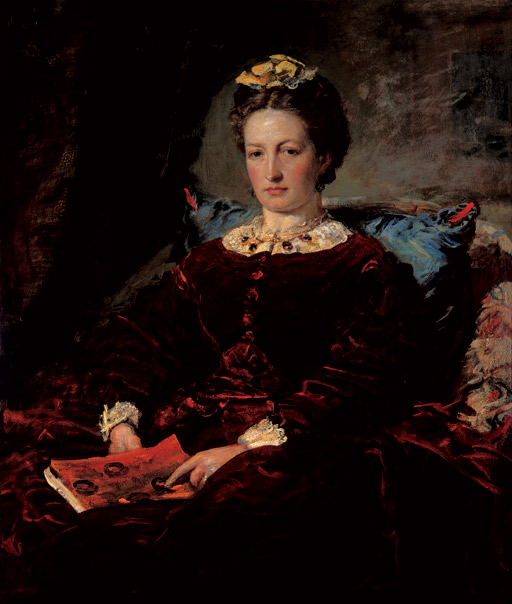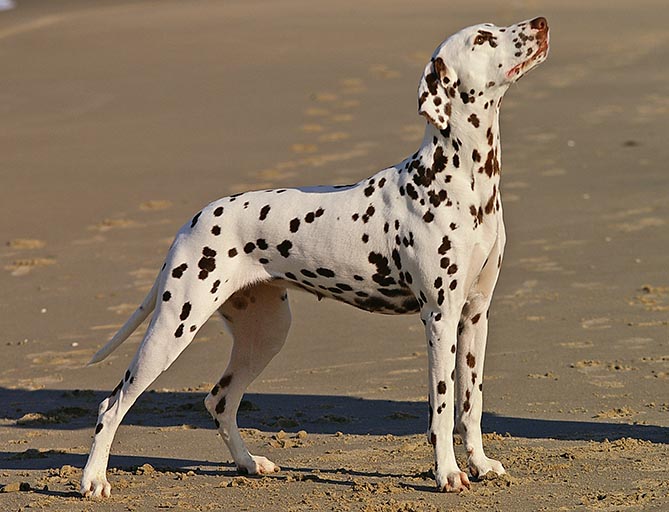|
Carriage Dog
A carriage dog or coach dog refers to a type of dog rather than a specific breed. Dogs of this type were usually bred and trained to trot alongside carriages to protect the occupants from banditry or other interference. They were usually owned and used by the wealthy or traders and merchants. The dogs were trained to attack the horses used by highwaymen A highwayman was a robber who stole from travellers. This type of thief usually travelled and robbed by horse as compared to a footpad who travelled and robbed on foot; mounted highwaymen were widely considered to be socially superior to fo ..., giving the owners' human security time to respond to the actual robbers. When the Dalmatian breed was introduced to England in the 18th century, they quickly became the carriage-dog breed of choice. Because of this, "carriage dog" became synonymous with "Dalmatian". The British Carriage Dog Society exists to preserve "the working heritage of the Dalmatian as a coaching dog." Previo ... [...More Info...] [...Related Items...] OR: [Wikipedia] [Google] [Baidu] |
Dog Type
Dog types are broad categories of domestic dogs based on form, function, or style of work, lineage, or appearance. Some may be locally adapted dog types (or ''landraces'') that may have the visual characteristics of a modern purebred dog. In contrast, modern ''dog breeds'' strictly adhere to long-established breed standards, that began with documented foundation breeding stock sharing a common set of inheritable characteristics, developed by long-established, reputable kennel clubs that recognize the dog as a purebred. A "dog type" can be referred to broadly, as in gun dog, or more specifically, as in spaniel. Dogs raised and trained for a specific working ability rather than appearance may not closely resemble other dogs doing the same work, or any of the dogs of the analogous breed group of purebred dogs. Names in English The earliest books in the English language to mention numbers of dog types are from the "Cynegetica" (hunting literature), namely, ''The Art of Venery'' (1 ... [...More Info...] [...Related Items...] OR: [Wikipedia] [Google] [Baidu] |
Breed
A breed is a specific group of domestic animals having homogeneous appearance (phenotype), homogeneous behavior, and/or other characteristics that distinguish it from other organisms of the same species. In literature, there exist several slightly deviating definitions. Breeds are formed through genetic isolation and either natural adaptation to the environment or selective breeding, or a combination of the two. Despite the centrality of the idea of "breeds" to animal husbandry and agriculture, no single, scientifically accepted definition of the term exists. A breed is therefore not an objective or biologically verifiable classification but is instead a term of art amongst groups of breeders who share a consensus around what qualities make some members of a given species members of a nameable subset. Another point of view is that a breed is consistent enough in type to be logically grouped together and when mated within the group produce the same type. When bred together, ind ... [...More Info...] [...Related Items...] OR: [Wikipedia] [Google] [Baidu] |
Carriage
A carriage is a private four-wheeled vehicle for people and is most commonly horse-drawn. Second-hand private carriages were common public transport, the equivalent of modern cars used as taxis. Carriage suspensions are by leather strapping and, on those made in recent centuries, steel springs. Two-wheeled carriages are informal and usually owner-driven. Coaches are a special category within carriages. They are carriages with four corner posts and a fixed roof. Two-wheeled war chariots and transport vehicles such as four-wheeled wagons and two-wheeled carts were forerunners of carriages. In the twenty-first century, horse-drawn carriages are occasionally used for public parades by royalty and for traditional formal ceremonies. Simplified modern versions are made for tourist transport in warm countries and for those cities where tourists expect open horse-drawn carriages to be provided. Simple metal sporting versions are still made for the sport known as competitive driving. ... [...More Info...] [...Related Items...] OR: [Wikipedia] [Google] [Baidu] |
Banditry
Banditry is a type of organized crime committed by outlaws typically involving the threat or use of violence. A person who engages in banditry is known as a bandit and primarily commits crimes such as extortion, robbery, and murder, either as an individual or in groups. Banditry is a vague concept of criminality and in modern usage can be synonymous for gangsterism, brigandage, marauding, and thievery. Definitions The term ''bandit'' (introduced to English via Italian around 1590) originates with the early Germanic legal practice of outlawing criminals, termed ''*bannan'' (English ban). The legal term in the Holy Roman Empire was ''Acht'' or ''Reichsacht'', translated as "Imperial ban". In modern Italian, the equivalent word "bandito" literally means banned or a banned person. The New English Dictionary on Historical Principles (NED) defined "bandit" in 1885 as "one who is proscribed or outlawed; hence, a lawless desperate marauder, a brigand: usually applied to members of ... [...More Info...] [...Related Items...] OR: [Wikipedia] [Google] [Baidu] |
The Cornhill Magazine
''The Cornhill Magazine'' (1860–1975) was a monthly Victorian magazine and literary journal named after the street address of the founding publisher Smith, Elder & Co. at 65 Cornhill in London.Laurel Brake and Marysa Demoor, ''Dictionary of Nineteenth-Century Journalism in Great Britain and Ireland''. Ghent: Academia Press and London: British Library, 2009. (p. 145). In the 1860s, under the editorship of William Makepeace Thackeray, the paper's large circulation peaked around 110,000. Due to emerging competitors, circulation fell to 20,000 by 1870. The following year, Leslie Stephen took over as editor. When Stephen left in 1882, circulation had further fallen to 12,000. ''The Cornhill'' was purchased by John Murray in 1912, and continued to publish issues until 1975. History ''The Cornhill'' was founded by George Murray Smith in 1859, and the first issue displayed the cover date January 1860. A literary journal with articles on diverse subjects and serialisations of ne ... [...More Info...] [...Related Items...] OR: [Wikipedia] [Google] [Baidu] |
Highwayman
A highwayman was a robber who stole from travellers. This type of thief usually travelled and robbed by horse as compared to a footpad who travelled and robbed on foot; mounted highwaymen were widely considered to be socially superior to footpads. Such criminals operated until the mid or late 19th century. Highwaywomen, such as Katherine Ferrers, were said to also exist, often dressing as men, especially in fiction. The first attestation of the word ''highwayman'' is from 1617. Euphemisms such as "knights of the road" and "gentlemen of the road" were sometimes used by people interested in romanticizing (with a Robin Hood–esque slant) what was often an especially violent form of stealing. In the 19th-century American West, highwaymen were sometimes known as ''road agents''. In Australia, they were known as bushrangers. Robbing The great age of highwaymen was the period from the Restoration in 1660 to the death of Queen Anne in 1714. Some of them are known to have been disban ... [...More Info...] [...Related Items...] OR: [Wikipedia] [Google] [Baidu] |
Dalmatian (dog)
The Dalmatian is a breed of dog, which has a white coat marked with black or brown-colored spots. Originating as a hunting dog, it was also used as a carriage dog in its early days. The origins of this breed can be traced back to present-day Croatia and its historical region of Dalmatia. It is thought that early ancestors of the breed were certain breeds of pointers and a spotted Great Dane. Today, it is a popular family pet and many dog enthusiasts enter Dalmatians into kennel club competitions. Characteristics Body The Dalmatian is a muscular dog with excellent endurance and stamina. When fully grown, according to the American Kennel Club (AKC) breed standard, it stands from tall. Coat Dalmatian puppies are born with plain white coats and their first spots usually appear within 10 days; however, spots may be visible on their skin from birth. They continue to develop until the dog is around 18 months old. Spots usually range in size from 2 to 6 cm (1.25 to 2.5 i ... [...More Info...] [...Related Items...] OR: [Wikipedia] [Google] [Baidu] |






